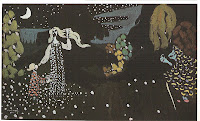
The other night I was reading a book about Kandinsky in Munich, looking at so many wonderful paintings. Also read about him making costumes for the theater. Some of his early works showed his interest in folklore, patterns and decoration. Hitler chose several Kandinsky paintings to be in his famous traveling exhibition of degenerate art. And I was reading about Kandinsky's use of "dots" or blobs, how he used them to fill out black figures against a black background. I was also thinking about the work of Vuillard, and Kathleen Fraser's poem about Vuillard and his mother, who was a seamstress. Somehow all of these threads (!) got tangled up in a poem I wrote. When I got to the end I realized I had made Kandinsky's mother into a seamstress. So I thought I'd better check the facts. Didn't seem likely. Kandinsky's mother left when he was 4 to marry another man, hardly the homemaker type. So I had to "adjust" the poem. Pulled in Jackson Pollock, too, and Mick Jagger, why not?
All this would make a good discussion about narrative ethics. Okay to have characters from different time periods in your poem, but making up a fact about one's mother, well that has to be out of line. You can have an imaginary tribunal, but not rewrite someone's childhood. So here's the poem.
Wassily Kandinsky’s Defense at the (Imaginary) Tribunal of Degenerate Artists
Yellow’s unstitching itself from the sun
— Kathleen Fraser
So you’d like me to connect the dots.
I was born too early to be a language poet, and I couldn’t have known Mr. Pollock.
Let’s take a look at one of my early works, “The Night,” from 1907.
The black that is not a being
backing up the black that is being
dots forming the outline, then filling in . . .
How do I know how close to come without re-entering the void?
The answer is simply that I had access to the seamstress’ muslins,
used her patterns to measure the torso, the waist, the width of the shoulders.
That said, all of this information internalized leaves me free to apply
the pigment in a manner you seem to find capricious, degenerate, even.
Mick Jagger, please meet Kathleen Fraser, I’d be happy to give you
pointers in your own presentations to the (imaginary) tribunal.
What part of black on black do you not understand?
Slip on a pair of glasses that magnify, perhaps you will find yourself in Paris,
on top of the Eiffel Tower surveying the city below, flashes of yellow on black.
Whether you find human figures or buildings, my dots are there to signify.
slopoet
Yellow’s unstitching itself from the sun
— Kathleen Fraser
So you’d like me to connect the dots.
I was born too early to be a language poet, and I couldn’t have known Mr. Pollock.
Let’s take a look at one of my early works, “The Night,” from 1907.
The black that is not a being
backing up the black that is being
dots forming the outline, then filling in . . .
How do I know how close to come without re-entering the void?
The answer is simply that I had access to the seamstress’ muslins,
used her patterns to measure the torso, the waist, the width of the shoulders.
That said, all of this information internalized leaves me free to apply
the pigment in a manner you seem to find capricious, degenerate, even.
Mick Jagger, please meet Kathleen Fraser, I’d be happy to give you
pointers in your own presentations to the (imaginary) tribunal.
What part of black on black do you not understand?
Slip on a pair of glasses that magnify, perhaps you will find yourself in Paris,
on top of the Eiffel Tower surveying the city below, flashes of yellow on black.
Whether you find human figures or buildings, my dots are there to signify.
slopoet
